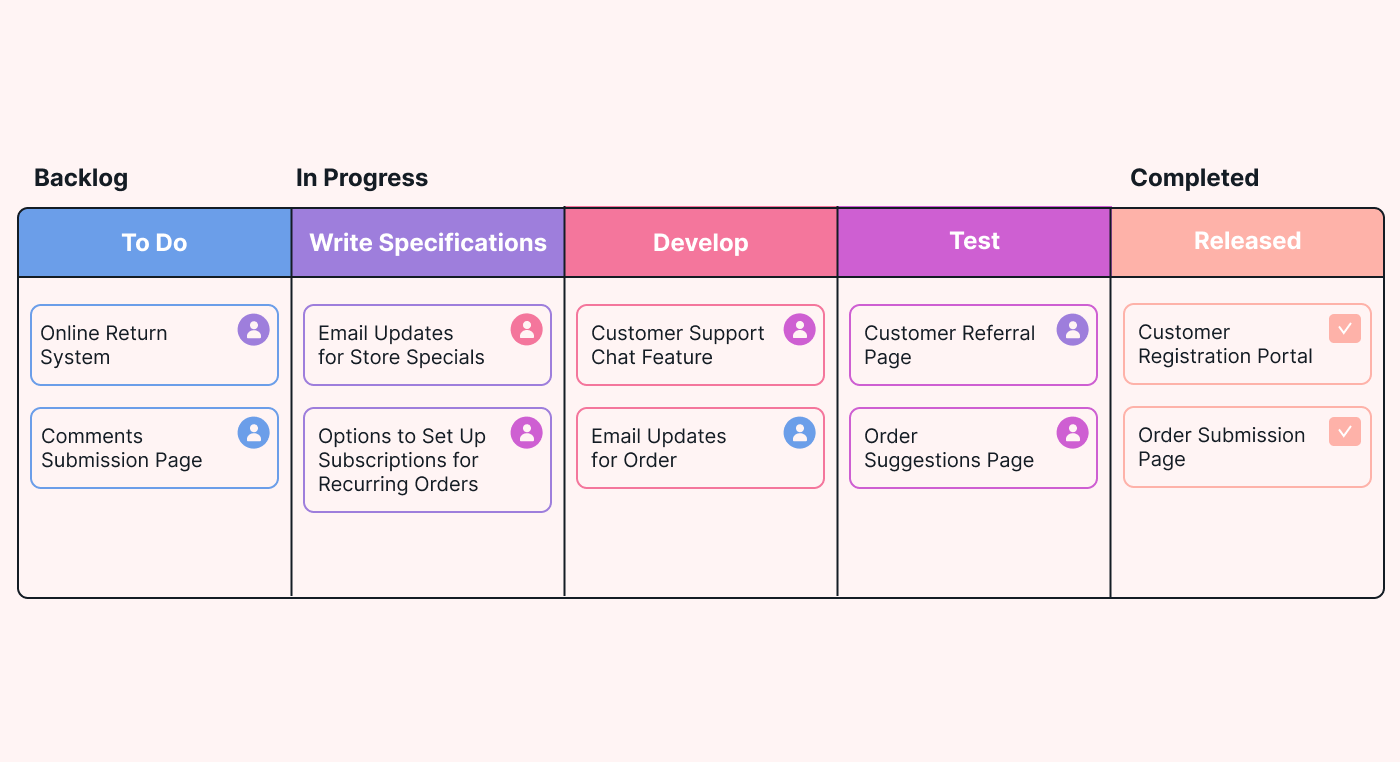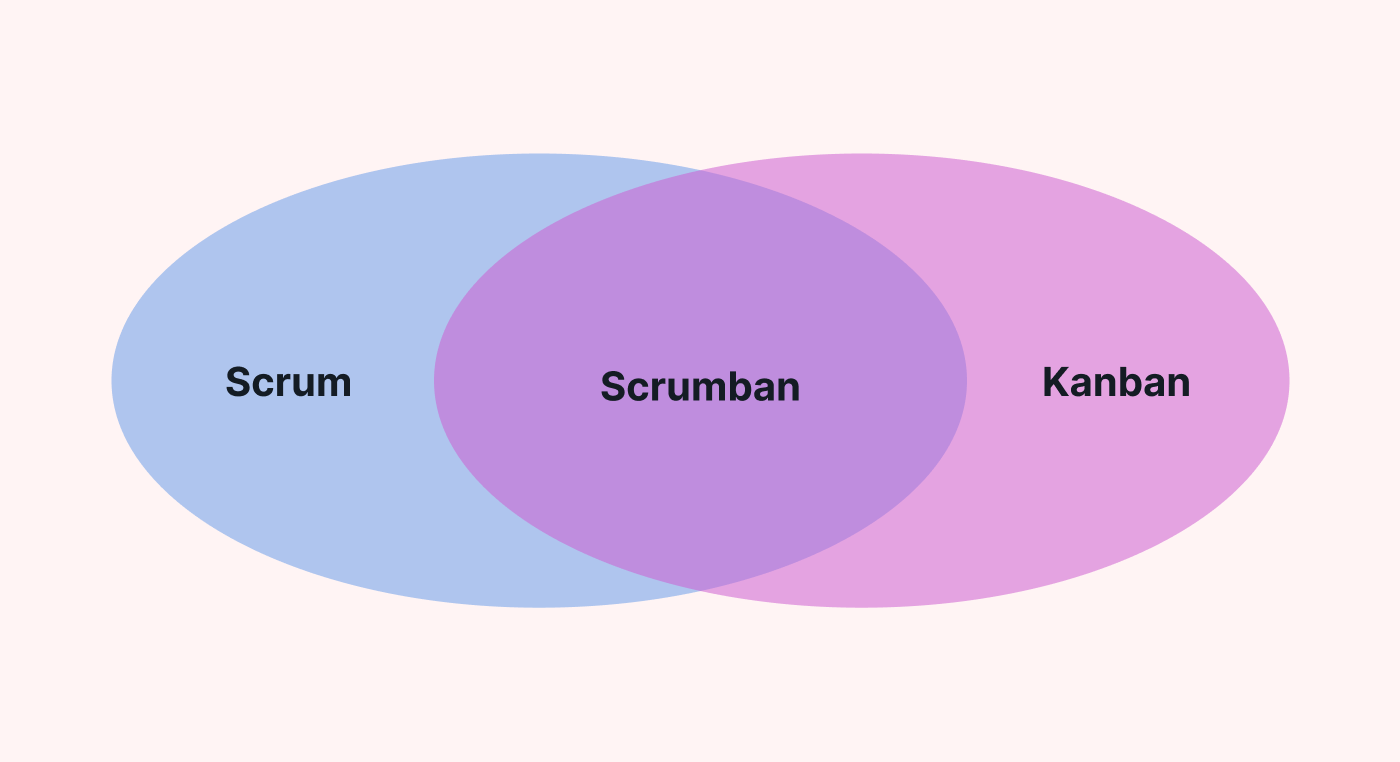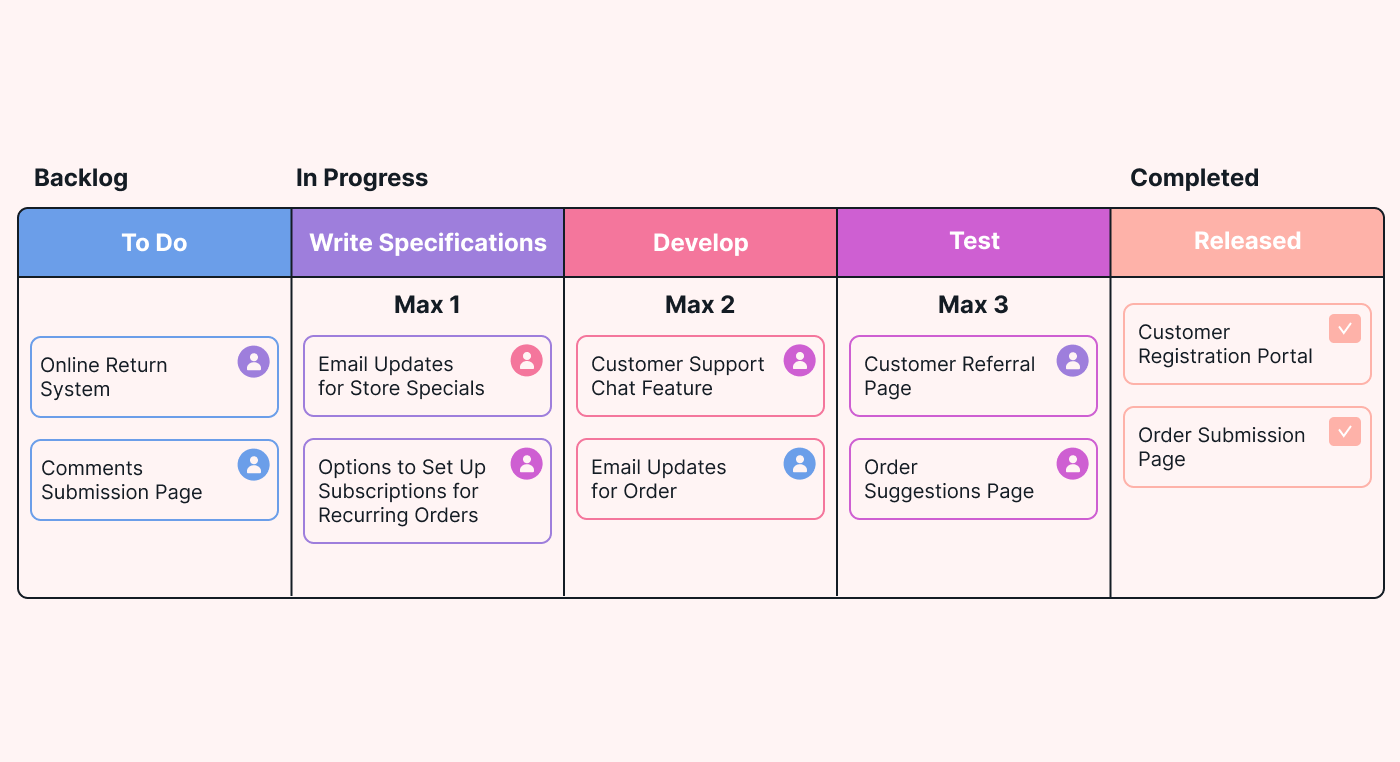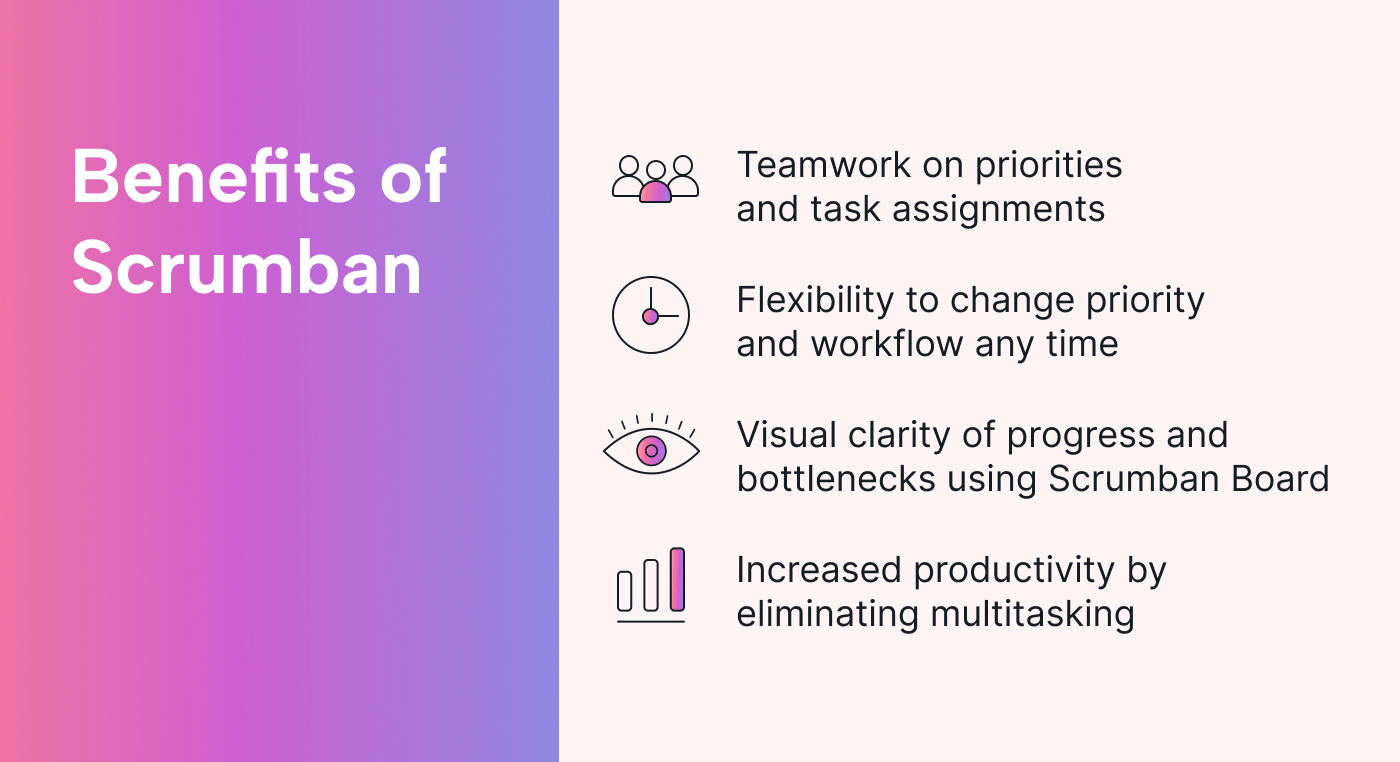Are you trying to implement Scrum or the Kanban method into your project management regimen but facing difficulties? Perhaps the daily meetings and sprint reviews aren’t getting work done? Or is the lack of an incremental approach in Kanban blocking your team from completing projects on time?
It may be time you considered a hybrid approach: Scrumban.
In this article, we will discuss:
- What is Scrumban?
- The Scrumban board
- Scrum vs. Kanban vs. Scrumban
- When a team should use Scrumban
- How to implement Scrumban
- Benefits of Scrumban
What is Scrumban?
Scrumban is a project management method that is a combination of two Agile frameworks: Kanban and Scrum.
In Scrumban, there is no team leader. The entire team organizes their roles, and members can pull new tasks to work on as they complete the ones in their pipeline.
Scrumban projects don’t have to have a deadline, even though tasks are worked in sprints.
Teams who practice Scrumban meet as needed rather than following a strict meeting schedule.
The Scrumban board
A Scrumban board is similar to a Kanban board. The Scrumban board has columns showing the project backlog from which the team will select tasks, currently in progress, and completed tasks.
 |
The team can determine what columns to include on the board to meet their needs. For example, a development team might consist of columns that show “Write Specifications,” “Develop,” and “Test” to reflect what stage a task is in.
Scrum vs. Kanban vs. Scrumban
Scrum
Scrum teams use time-boxed sprints to complete work. A time-boxed sprint is an agreed-upon timeframe, usually 1-4 weeks.
There is a planning meeting before the start of a sprint to plan what work the team will complete in the sprint.
During the sprint, the team has daily standups. The standup is a meeting to discuss their progress and any issues they need to resolve to keep their tasks on schedule.
The team has a sprint retrospective meeting at the end of each sprint to discuss what went well and what they can improve upon for the next sprint.
Scrum team roles include a Scrum master and product owner. The remaining team members complete the work. For example, a software development team using Scrum includes business analysts, developers, and QA testers.
Kanban
Kanban differs from Scrum because it does not use sprints or specified time frames when planning work. Instead, Kanban sets work-in-progress (WIP) limits for how many tasks the team can handle at any given time. When a task is completed, work begins on a new task.
Kanban does not have specific team roles like Scrum. Instead, the team uses a definition of workflow (DoW) to determine what it means to start and complete a task. The DoW also defines how long a task should be in each status.
Since the team does not plan work for a particular time like a sprint, there is more continuous planning and prioritization by the project manager.
Scrumban
Scrumban methodology combines elements of Scrum with elements of Kanban.
Scrumban uses the iterations of sprints like Scrum, along with the sprint planning and retrospective meetings Scrum uses.
 |
Scrumban uses the WIP limits of Kanban and a planning board like Kanban.
When should a team use Scrumban?
There are several situations where the Scrumban methodology can be helpful in a team.
A team can use Scrumban to transition between Scrum and Kanban.
Scrumban is useful if a project is ongoing with no specific due dates. For example, a development team might be doing a redesign of their corporate website that doesn’t have a due date. The company does want the team to work on it and make changes, but the current website is adequate. There is no hard deadline to meet a client implementation, and redesigning all pages will be an ongoing project.
It also helps team members who will benefit from more independence. The lack of roles in Scrumban gives everyone an equal say in what they should do. If a team has worked together for years and has many subject matter experts, they will be good at agreeing on priorities without having a team leader set them. They also know their areas of expertise and can pull tasks to work on that they are efficient at accomplishing. Effective teams can run smoothly.
How to implement Scrumban
Let’s take a look at the steps to implement the Scrumban methodology.
Create a Scrumban board
First, your team should create a Scrumban board.
Your team should discuss what columns to include on your board to accurately reflect what is being worked on, depending on the types of projects your team completes. Let’s build on the example of the development team we used earlier.
The team could call the backlog items column “To do.”
Next, they should define the different phases of work in progress. For our example development team, projects require specifications, development, and testing to complete the software development process. The team will create a column for each step of the process on their board.
The business analyst will have assignments in the “Write Specifications” column. The developer’s work will be under the “Develop” column. The QA tester’s work will be under the “Test” column.
To complete a software feature, the team will release it. They might name the completed column “Released” to better define what complete means to them.
Establish WIP limits
After creating the board, a team should discuss how many tasks they will commit to work on at a time for each column.
For example, if there is one business analyst to write specifications for a team, it might make sense for them to work on one task at a time. If there are two developers, each could work on a development task. Let’s assume the team has two testers who sometimes send projects back for fixes and are waiting for the project to return to them before they can work on it again. The team may decide that three tasks can be in QA at any given time to account for the back and forth on projects.
The team should also consider the time each task is expected to stay in each column, which the team will define in the DoW. The team should ensure that the maximum number of tasks they set for each column is reasonable to allow the responsible team member to move the task to the next column on time.
The Scrumban board should clearly show the WIP limits, and the team should not go over these limits.
 |
Over time, the team may need to change the WIP limits. The process should be flexible. For example, if the team expands and hires more team members, the team can complete more work. If a team member is on a leave of absence or a senior team member leaves the company, the team will need to decrease how many tasks they can commit to with the staffing change.
Prioritize tasks
Everyone on the Scrumban team has an equal say in what the team will work on when they meet to discuss priorities. They should work together to determine what tasks in the backlog they should work on first.
After the initial prioritization of the backlog, the project team should meet to reprioritize tasks as needed. They can call an on-demand planning meeting whenever there is a need for one.
For example, if a company signs a new client with a contract specifying a go-live date, the team might need a special planning session for high-priority tasks they must complete for the client’s go-live date.
Set meeting schedule
The project team should determine how long their iterations will be. Note that iteration length can be changed in the future if the timeframe a team picks isn’t working well for them.
The team should determine how often they should meet to prioritize the backlog. Consider factors such as how often new tasks are added to the backlog and how often the business needs change. Try to find a balance between meeting often enough to evaluate priorities, and meeting so often that the team loses valuable working time. Note that a planning meeting can be called upon demand if a team determines a need, such as a shift in priorities.
Consider having a retrospective at an agreed-upon interval to discuss what is going well and the team’s suggestions to improve the process.
The team should discuss whether daily standup meetings, to discuss what each team member is working on and any obstacles they face, will benefit the team.
Benefits of Scrumban
Scrumban methodology offers many benefits.
- Teamwork is valued, which creates a motivated team.
- Each team member has an equal say in priorities and can pull their own assignments.
- Collaboration between team members is increased.
- Team members will likely be more enthusiastic about working on tasks they hand-pick rather than a manager assigning them tasks.
Scrumban combines the best of Scrum and Kanban, allowing more flexibility to react to changing priorities. Companies with fast-paced environments and constantly changing priorities will benefit from being able to reprioritize projects as needed.
The Scrumban board allows visualization of what the team is working on at any time. The columns provide a process overview to other teams showing what is required to complete a project. Visualizing work allows a team to quickly see if a particular column is becoming a bottleneck.
For example, if the development column is always causing delays in the workflow, the team should evaluate what is happening.
- Are the requirements clear, or are the developers getting stuck waiting for clarification on parts of the specifications?
- Is there an issue with the development environment (for example, systems are running too slowly) that requires an upgrade for faster processing?
- Is there an area the developers could use more training in to help them get up to speed on a new technology they are using, to reduce development time?
- Or is it simply a matter of being understaffed and needing to hire more developers?
The team can also see if tasks are moving quickly through a column and if a part of the team lacks work. For example, if the QA team is always waiting for work to get to them after they request fixes on a project, the team can discuss increasing the maximum limits of tasks allowed in the QA column at a time.
 |
Scrumban increases productivity by reducing or eliminating multitasking. Team members can choose what to work on without consulting a manager or waiting for new assignments. The team can stay focused on completing tasks.
How Motion can help your Scrumban tasks
When your team uses Scrumban to complete tasks, use Motion to keep your project workflow moving so you can work through your backlog more efficiently.
Motion can handle all stages of a Kanban board. You can enter tasks into Motion. When team members are ready to work on it, they can pull the task into their schedule.
Motion also recognizes task dependencies and will alert you if a dependent task will be delayed because another task is blocking it. The alert helps ensure your team works on tasks in the correct order.
Motion doesn’t just add a task to an available spot in your schedule but instead rearranges your existing schedule by considering all your tasks and priorities. Motion even alerts you if a task will not meet a deadline, so you can discuss options such as reassigning it to someone else or reprioritizing other tasks.
If you are not already using Motion, start your free trial today.






